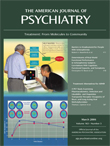Risperidone for the Core Symptom Domains of Autism
To the Editor:
As clinicians with interest in evidence-based psychopharmacology, we would like to express our deep reservations about the article on the effects of risperidone on the core domains of autism by Christopher J. McDougle, M.D., et al. (1). Our concern about this article cannot be fully appreciated without reading the initial study published in 2002 in the New England Journal of Medicine(2). Creating multiple articles from a single study, and publishing the outcomes in different journals, does not only mislead readers that there is much more evidence than there really is, but it could also be a significant source of publication bias in future meta-analyses.
In the basic design, the authors failed to mention how their group size was determined and if a power calculation was done because this would have had an effect on the interpretation of their results. Apart from this, the authors did not mention why they thought the results achieved from their nonvalidated parent rating scale with its inherent bias would be more generalizable than if they had used the Ritvo-Freeman Real Life Rating Scale.
While interpreting the results, the authors failed to mention the possibility that fatigue (experienced by 59% of the patients) and drowsiness (experienced by 50% of the patients) could have been responsible for reduced irritability and aggression. In the conclusion section, the authors could not resist writing that there was a “nearly significant difference” between risperidone and placebo in the social domain at p<0.07 (p. 1146). Without computing the confidence interval, proclaiming that a difference was “nearly significant” is unscientific and to a lay reader may be inadvertently deceptive. If the p value had been <0.04, would they have concluded that the difference between risperidone and placebo was “nearly insignificant”? Furthermore, the authors bizarrely blamed the rating instrument for the lack of significant differences between risperidone and placebo on the social domains rather than concluding the obvious: that risperidone was not statistically better than placebo.
In conclusion, we believe that, based on this study, it would be misleading to state the effectiveness of risperidone on any domain of autism and would like to emphasize to clinicians that although research continues on pharmacological intervention, the behavioral approach still has the broadest empirical validation for effectiveness and has been shown to play a significant role in enhancing functioning (3).
1. McDougle CJ, Scahill L, Aman MG, McCracken JT, Tierney E, Davies M, Arnold LE, Posey DJ, Martin A, Ghuman JK, Shah B, Chuang SZ, Swiezy NB, Gonzalez NM, Hollway J, Koenig K, McGough JJ, Ritz L, Vitiello B: Risperidone for the core symptom domains of autism: results from the study by the Autism Network of the Research Units on Pediatric Psychopharmacology. Am J Psychiatry 2005; 162:1142–1148Link, Google Scholar
2. Research Units on Pediatric Psychopharmacology Autism Network: Risperidone in children with autism and serious behavioral problems. N Engl J Med 2002; 347:314–321Crossref, Medline, Google Scholar
3. Schreibman L: Intensive behavioral/psychoeducational treatments for autism: research needs and future directions. J Autism Dev Disord 2000; 30:373–378Crossref, Medline, Google Scholar



